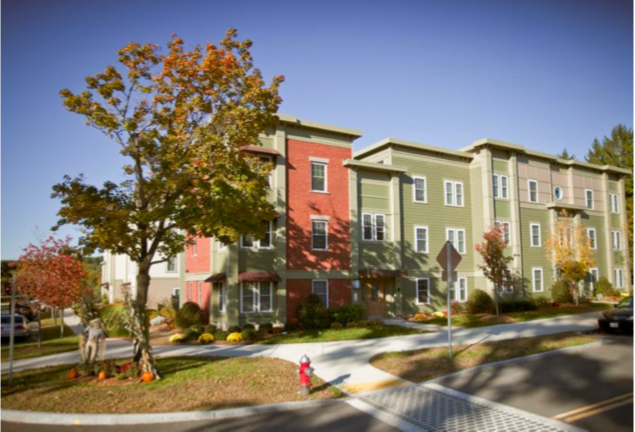SMART GROWTH FORUM FOCUSES ON POTENTIAL FOR AFFORDABLE HOUSING IN AMHERST

Village Hill, A 40 R Development in Northampton. Photo: Mass.gov (Northampton, A 40R Community).
By Maura Keene
On April 4, about 50 people gathered at Crocker Farm School to hear state housing officials explain incentives for building more housing and affordable housing in Amherst. Amherst’s housing stock exceeds the mandated state minimum percentage of 10 percent affordable housing units, at 11.5 percent. Nonetheless, a significant proportion of Amherst’s residents struggle with their housing costs. According to Dana LeWinter of Citizens Housing and Planning Association, a national affordable housing advocacy group, over 50 percent of renters and 20 percent of homeowners in Amherst spend more than 30 percent of their income on housing. Also, there are currently 700 fewer families with children in Amherst than there were in the year 2000, meaning roughly 1,000 fewer children in the schools, which may suggest that younger families are finding it difficult to find affordable housing in Amherst.
With these facts in mind, the Amherst Housing Trust is using a $45,000 grant for consultants to research sites in Amherst that would be approriate for 40R Smart Growth Overlay Districts.
40R is a statewide program that offers assistance to communities and developers to provide more affordable housing with compact, mixed use designs (single or multifamily) that is close to transportation and community services. Projects may have up to 80% market rate units if they include at least 20% affordable units, guaranteed for at least 30 years. These developments are overlay districts and consequently do not need to conform to existing zoning. Districts of one building to several acres can be created but these must be high density housing. Minimums are 8 single family homes per acre, 12 two-three family homes per acre or 20 housing units per acre for multi-family dwellings.
Regulations for developments under 40R zoning were presented by William Reyelt of the Massachusetts Department of Housing and Community Development. The state will provide up-front unrestricted cash payments to cities and towns of between $10,000 and $600,000 for designating 40 R zones plus $3,000 per unit in unrestricted cash payments for each unit that is built.
Incentives for developers, in addition to replacing zoning with overlay districts includes fast tracking of projects within 120 days of receipt of applications by the municipal clerk and unlike 40B projects that limit profits to 20 % of project costs, unlimited profits.
The state will also offer annual payments to the cities and towns if costs for the number of children added to the public schools exceeds the additional revenue from property taxes.
Northampton has used 40R zoning for the Village Hill development and the single room occupancy building on Pleasant Street. Other developments in the state that were built under 40 R were described by Larry Field of Massachusetts Smart Growth Alliance.
After Amherst was awarded the study grant, consultant Karen Sunnarborg from Karen Sunnarborg Consulting conducted site reviews and interviews with Amherst residents to determine what is appropriate for Amherst. David Eisen from Abacus Architects and Planners will consult on form based regulations in 40R districts. Their final suggestions will be presented at subsequent meetings.
Since the town receives approximately $3000 for each housing unit created, plus an upfront payment for adopting 40 R, there is a financial incentive for municipal governments to approve creation of these districts.
But there may be a downside to these developments. Although the projects must be approved by town government, due to the complexity and the evolving status of the 40 R regulations, it is unclear whether the town will have substantial control over siting, appearance, scale and massing and quality of the buildings under state 40R regulations. The quotes that follow, taken from 40R guidance, highlight potential limitations on local control.
“A fundamental premise of Chapter 40R is that design standards should function within the framework of the public interest, which means they must not add unreasonable costs to residential or mixed-use developments or otherwise impair the economic feasibility of proposed projects. To this effect, municipalities must be able to demonstrate that the proposed Design Standards will not Unduly Restrict the development of Projects in the District as a requisite for obtaining Smart Growth Zoning approval.” ( Chapter 40R | Mass.gov).
“While all residential and mixed use development must be as-of- right in a smart growth zoning district, communities can use design review to regulate the physical character of the development as long as requirements are not unduly burdensome.” (Smart Energy Tool Kit, Mass.gov).
Also, although these projects must designate 20% affordable units, after 30 years they can be sold to a commercial development and all units can subsequently be rented or sold at market rates. This happened in 2013 when Amherst’s Echo Village Apartments, were sold, and 19 low income families lost their homes suddenly after affordability provisions expired.
Although there is clearly a need for more affordable housing in Amherst, there are many aspects to development that need to be considered, not the least of which is the impact these high density projects. will have on the surrounding neighborhoods.

2 thoughts on “SMART GROWTH FORUM FOCUSES ON POTENTIAL FOR AFFORDABLE HOUSING IN AMHERST”